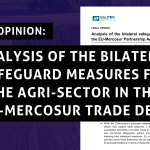The European Commission’s updated Industrial Strategy published last week was largely disappointing due to how little attention it gives to getting the industry on track to meet key EU environmental and climate objectives. This despite the considerable transformation needed in many important sectors if those targets are to be met, writes Wendel Trio.
This op-ed was originally published by Euractiv, on 11 May 2020.
Wendel Trio is the director of Climate Action Network (CAN) Europe.
Despite some lip service to the coming ‘Fit for 55’ legislative package and a surprise mention of sustainable product design – although, interestingly, with no reference to the upcoming sustainable product legislative initiative – as well as circularity, the Strategy provides little detail on where it is trying to get industry to go. It reinforces European Commission DG Internal Market, Industry, Entrepreneurship and SMEs (DG GROW) affection for Alliances and continues to set out more and more tools to provide larger and larger sums of money to industry for a vague green and digital transition, but with no framing on how to get there.
In addition to Alliances, the updated Strategy builds an element of structure on ‘industrial ecosystems’, those value chains of importance to the EU economy and needing support due to the Covid pandemic’s negative impacts of economic performance. These industrial ecosystems could ‘co-create’ transition pathways in partnership with industry, public authorities, social partners and other stakeholders – we presume this to mean at least civil society organisations. This is a similar approach as the one developed for Alliances, with the same shortcomings unless important issues are not addressed. There are at least three.
Lack of governance and framing by the European Commission
Civil society organisations have begun voicing serious concerns about the running of Alliances by DG GROW as love-ins between it and incumbent industry – energy-intensive sectors and fossil gas, at least. These bodies ultimately provide the industry with yet another forum to voice their views and recommendations on policy developments, of which the Clean Hydrogen Alliance and the recent debacle on the sustainable taxonomy is a textbook case.
What we needed from this strategy is clarity on what is expected from the industry in contributing to meeting European Green Deal goals. We also needed clarity on rules of engagement in Alliances and other bodies, the rules of the game to ensure that trust can be built and maintained amongst participants. Ultimately, we needed clarity on the European Commission’s position in these bodies, and how coherence with wider EU policies would be safeguarded.
Instead, we have the suggestion of the creation of at least four more Alliances, and now the development of ‘transition pathways’ for industrial ecosystems ‘where needed’. Who will decide this?
Hide the problem under a pile of free money
The updated strategy sets out various measures to provide money to industries with no detail on what is expected from recipients. Carbon contracts for difference, State Aid rules on Important Projects of Common European Interest (IPCEI), cohesion policy funds, a clear overlap period between the EU Emissions Trading System free allowances and the carbon border adjustment mechanism. At least there is mention of the reinforcement of the commitment to the green and digital transition in relation to the EU Budget, NextGenerationEU and the Recovery and Resilience Facility. What does this mean, and how will it be enforced? The strategy adds little to no value to these.
What is the problem anyway?
Beyond the irony of the section ‘Supporting the business case for the green and digital transitions’ focusing almost entirely on public funding sources, what is introduced as necessary elements of this business case is largely overlooked throughout the document. The strategy does not build toward or show support for a coherent and stable regulatory framework, reduced resource and energy use, or demand-side measures for climate-neutral and circular products. It blatantly sidesteps these important, interlinked issues, parroting energy-intensive industries that continue their narrow focus on technological decarbonisation through fuel switches and end-of-pipe carbon capture technologies.
This updated Industrial Strategy could have been a transformative puzzle piece to the massive construction efforts to get an EU policy framework that is fit for 1.5°C, linking with at least what is to come on sustainable product policy and industrial emissions, to help tackle interlinked objectives of biodiversity protection, circularity and zero pollution in a toxic-free environment. To provide the necessary certainty to get the industry on the right track we need transition pathways to include targets, milestones and monitoring and evaluation processes on a regular basis. The ‘Fit for 55’ legislative package is the earliest opportunity to bring about the policy and regulatory certainty that needs to be strengthened by the sustainable product initiative and Industrial Emissions Directive later this year. In so doing, carbon pricing, and product and production process legislation can be aligned to clearly show the way forward. These would get the industry moving in the right direction and at a good speed of travel towards climate neutrality.



